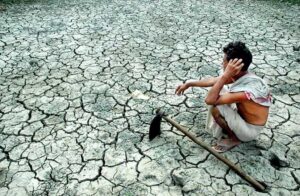Physical Address
23,24,25 & 26, 2nd Floor, Software Technology Park India, Opp: Garware Stadium,MIDC, Chikalthana, Aurangabad, Maharashtra – 431001 India
Physical Address
23,24,25 & 26, 2nd Floor, Software Technology Park India, Opp: Garware Stadium,MIDC, Chikalthana, Aurangabad, Maharashtra – 431001 India

A drought can last weeks, months and years. It is unpleasant because the sun always faces us and we don’t feel the cold that comes with the rain. Drought is a prolonged dry period in the natural climate cycle that can occur worldwide. It is a slow-onset disaster characterised by the lack of precipitation, resulting in a water shortage.
Climate change has further altered the natural pattern of droughts, making them more frequent, longer, and more severe. Inter-Governmental Panel for Climate Change (IPCC, 2007) has projected that Global Warming is increasing droughts. Therefore, it is essential to monitor the drought occurrence.
However, precisely quantifying droughts and wet spells is problematic because these extreme events have many definitions. We could identify several types of droughts from the online survey. Let’s consider them one by one.
Meteorological drought
It is brought about during a prolonged period with less-than-average precipitation. Meteorological drought usually precedes other kinds of lack.
Agricultural droughts
They are droughts that affect crop production. This condition can also arise independently from any change in precipitation levels, soil condition and erosion triggered by poorly planned agricultural attempts, causing a shortfall in water available to the crops. However, traditional droughts are caused by an extended period of below-average precipitation.
Hydrological drought
It is brought about when the water reserves available in sources such as lakes and reservoirs fall below the statistical average. Like an agricultural drought, this can be triggered by more than just a loss of rainfall.
Socioeconomic drought
It associates the supply and demand of some economic goods. Its occurrence depends on the processes of supply and demand. Socioeconomic drought occurs when the need for financial interest exceeds the collection due to a weather-related shortfall in the water supply. The deficiency may result in significantly reduced hydroelectric power production. Prolonged periods of dry weather are not uncommon in the hydrological history of Sri Lanka.
Droughts in Sri Lanka
The delay of monsoon onset or the temporal variability of the rainfall mainly affected the drought in Sri Lanka. However, Past studies have shown that droughts are related to other global teleconnections such as El Nino Southern Oscillation (ENSO), Indian Ocean Dipole (IOD), and North Atlantic Oscillation (NAO) etc.
When considering droughts, history goes up until the king’s era. According to the Mahawansa, a drought occurred even in 161-137 BC. During the last century, the droughts of 1908 and 1911 were the most extensive droughts. The most recent severe drought was in 2001. It severely affects the dry zone and intermediate zone. After that 2014, 2016, 2017 and recently, we can hear of prolonged droughts every year.
How to monitor droughts in Sri Lanka
Standard Precipitation Index (SPI) is a drought monitoring system in Sri Lanka. The SPI calculation for any location is based on the long-term precipitation record for a desired period. We found an accurate analysis of SPI in Sri Lanka in 2001.

According to this, July, August and October, November, and December were the months that droughts occurred. From the colour variation of this map, how these droughts affected Island-wide in the year 2001 can be identified. Let’s look into some recent studies.
In the year 2014, droughts were reported in March. Over 1.8 million people were affected, mainly in Northern, North Central and Southern Provinces, and severe agricultural loss was reported. In 2016-2017, droughts severely impacted about 900,000 people, mainly in Eastern and Northern provinces. This also highly affected the agriculture sector.
Most of the people in rural areas use groundwater for domestic purposes. As well as, their livelihood is highly dependent on agriculture. Therefore, people in rural areas are highly vulnerable to droughts. As estimated, the rural population there was 18,287,000 (18%) in 2017, a considerable amount. Farmers are mainly affected. Almost everyone has been affected by water insecurity.
If you have any queries or come across suspicious content related to climate change or the environment and want us to verify them for you, then send them to us on our WhatsApp hotline: +917045366366